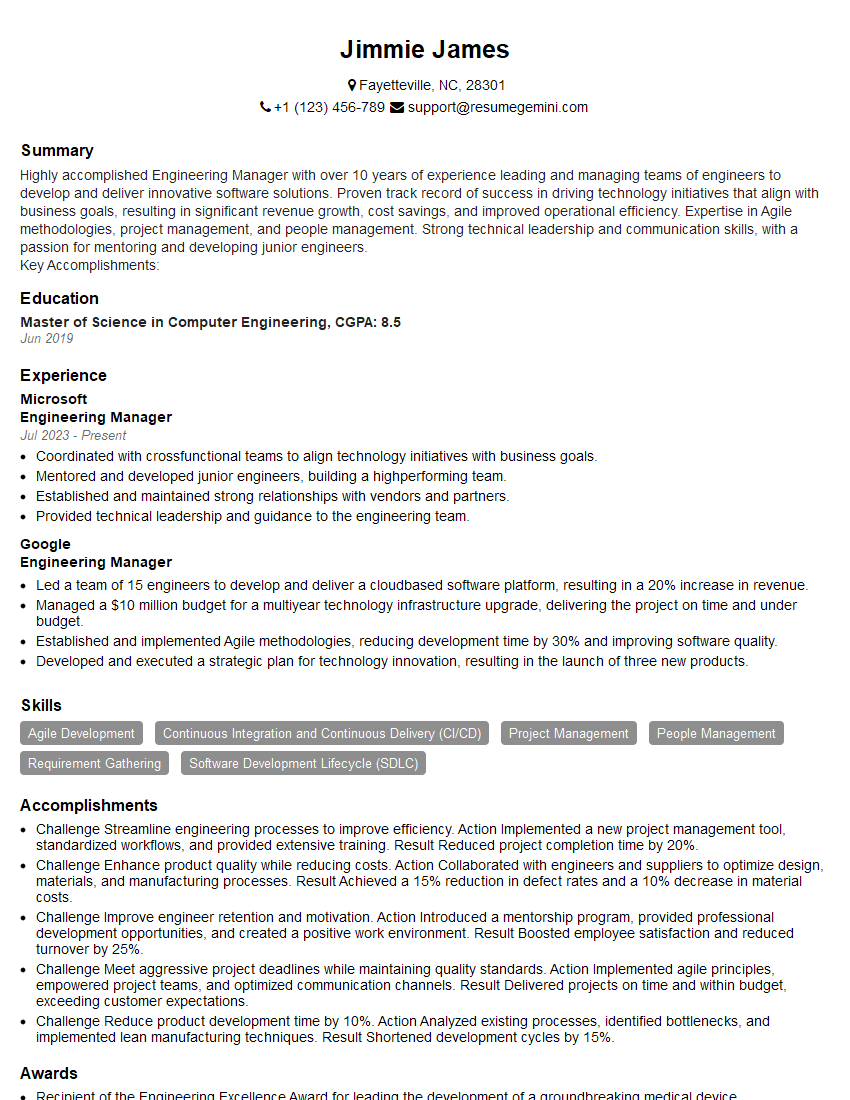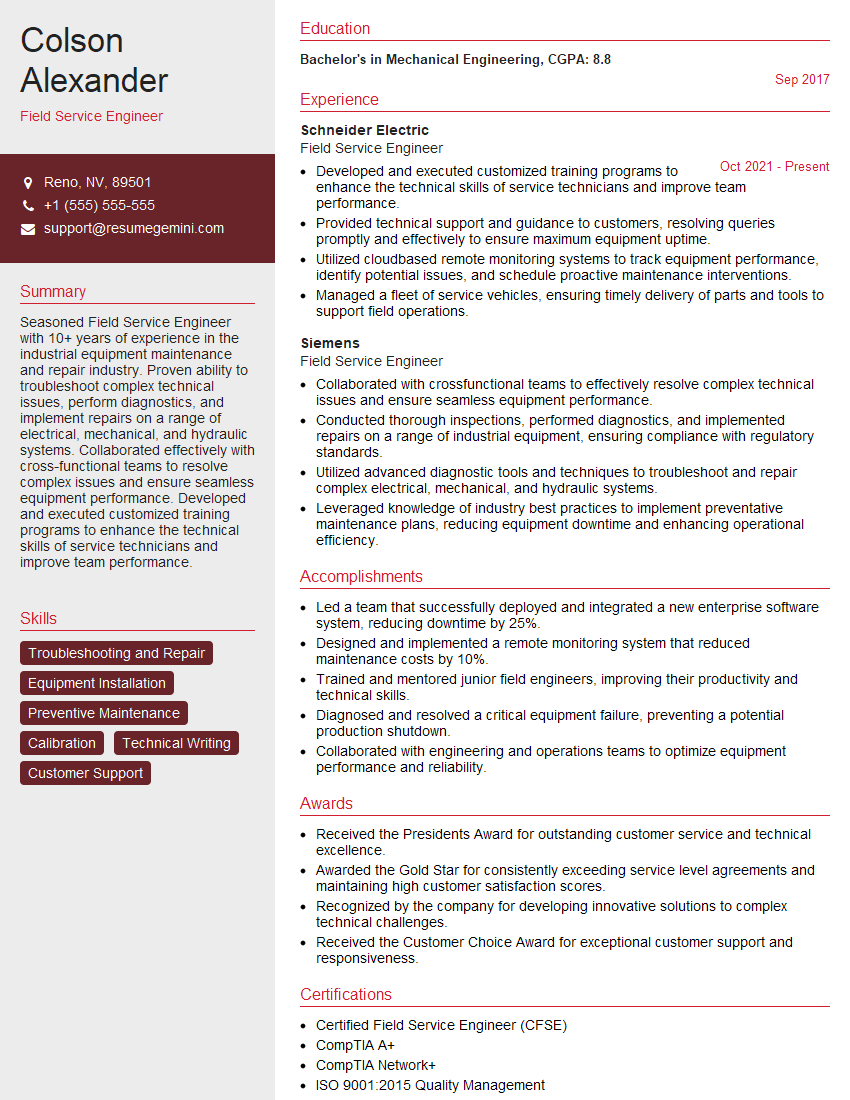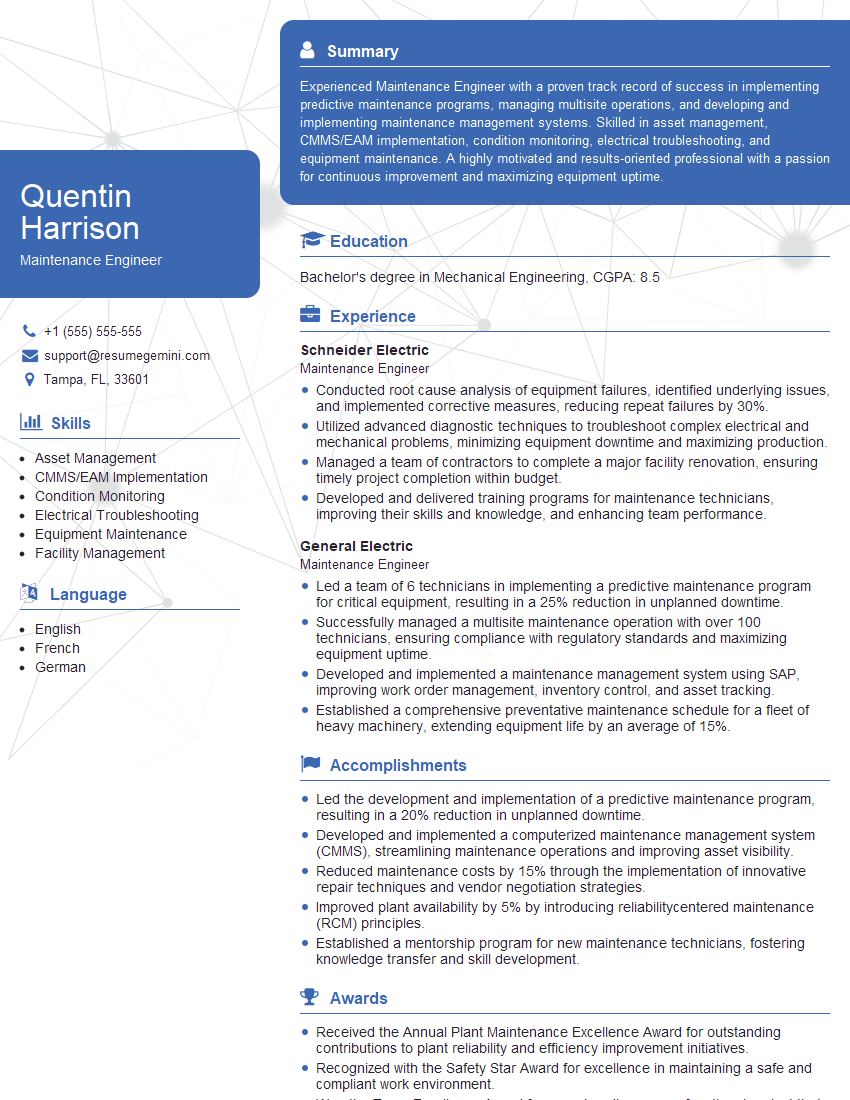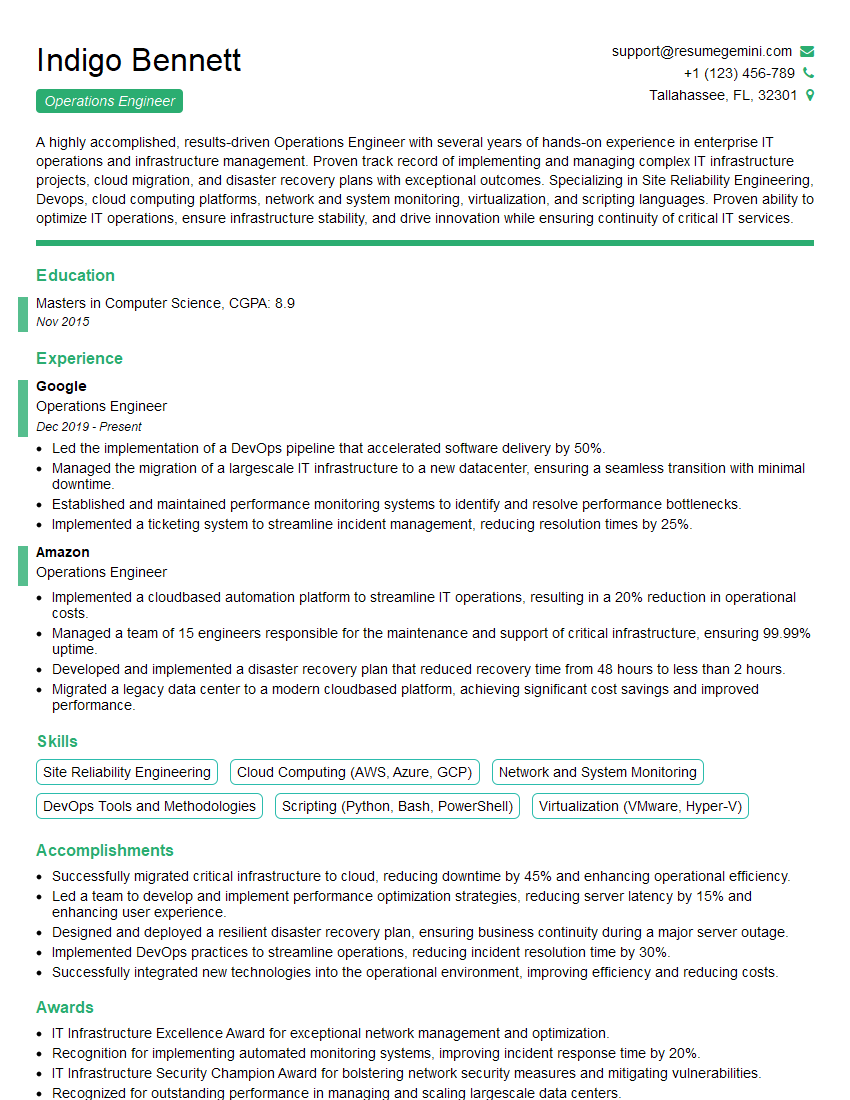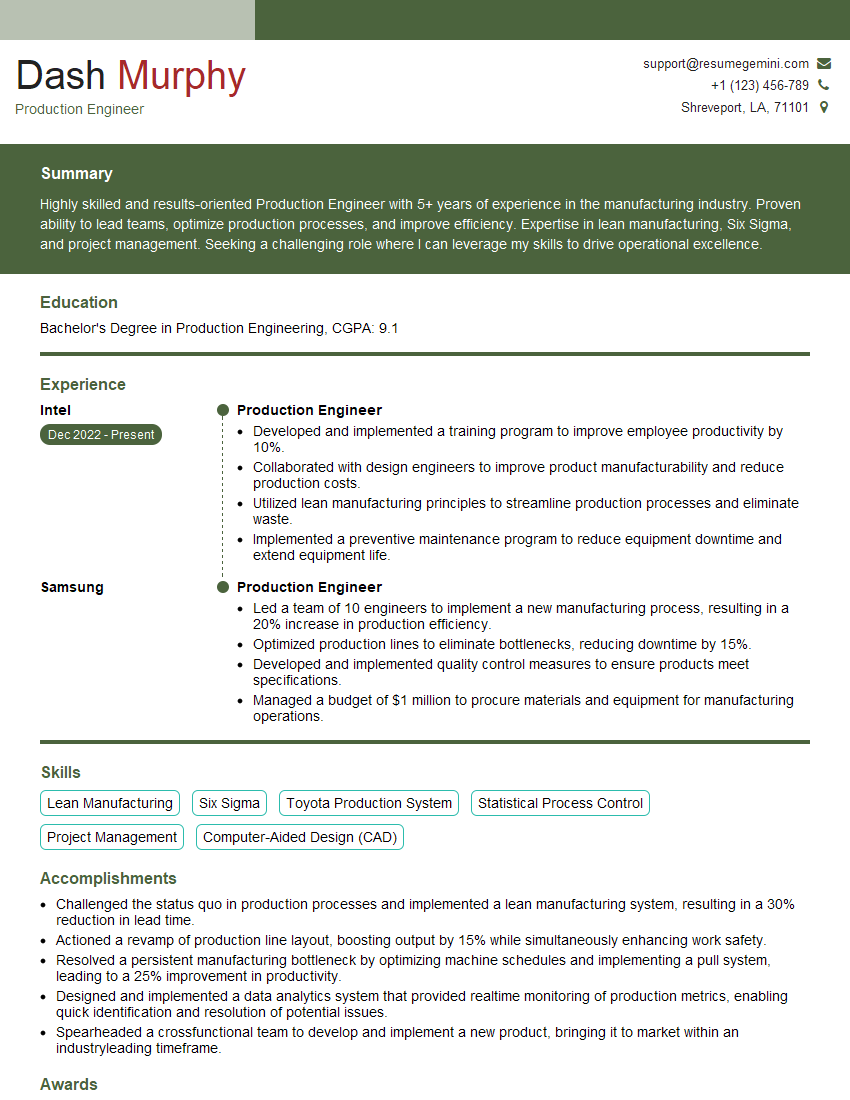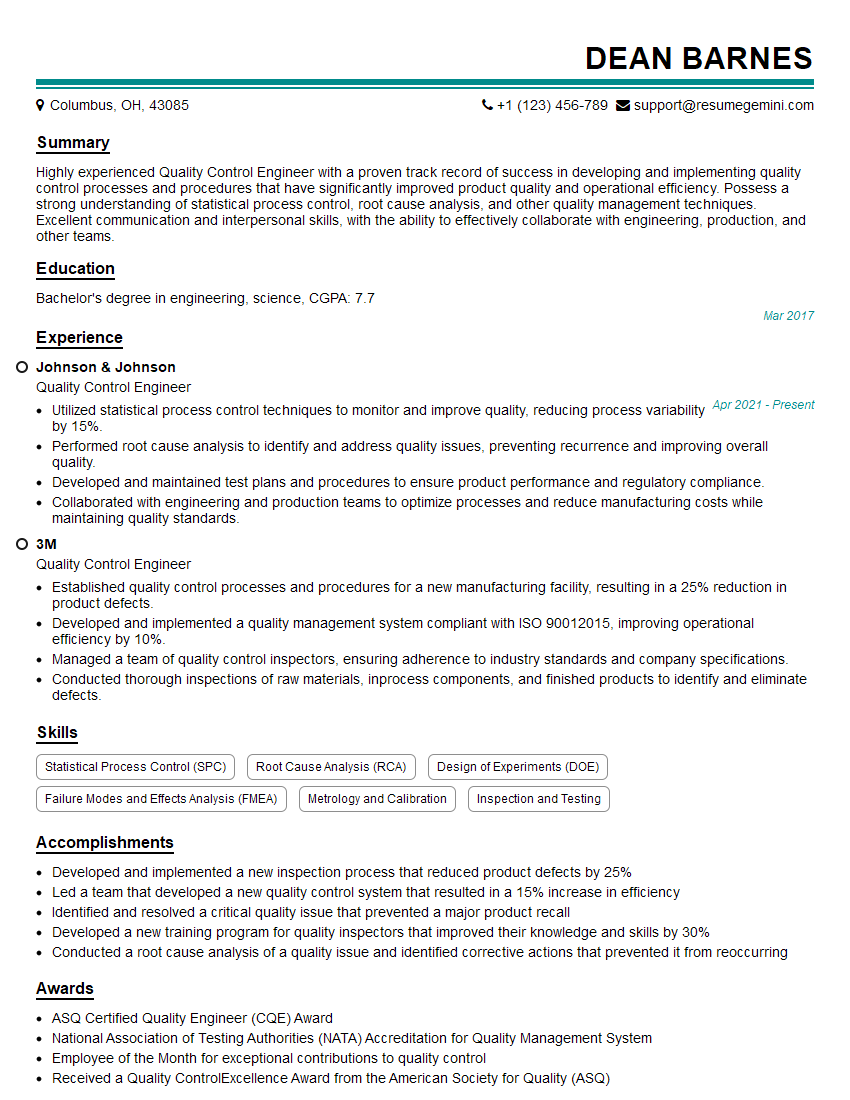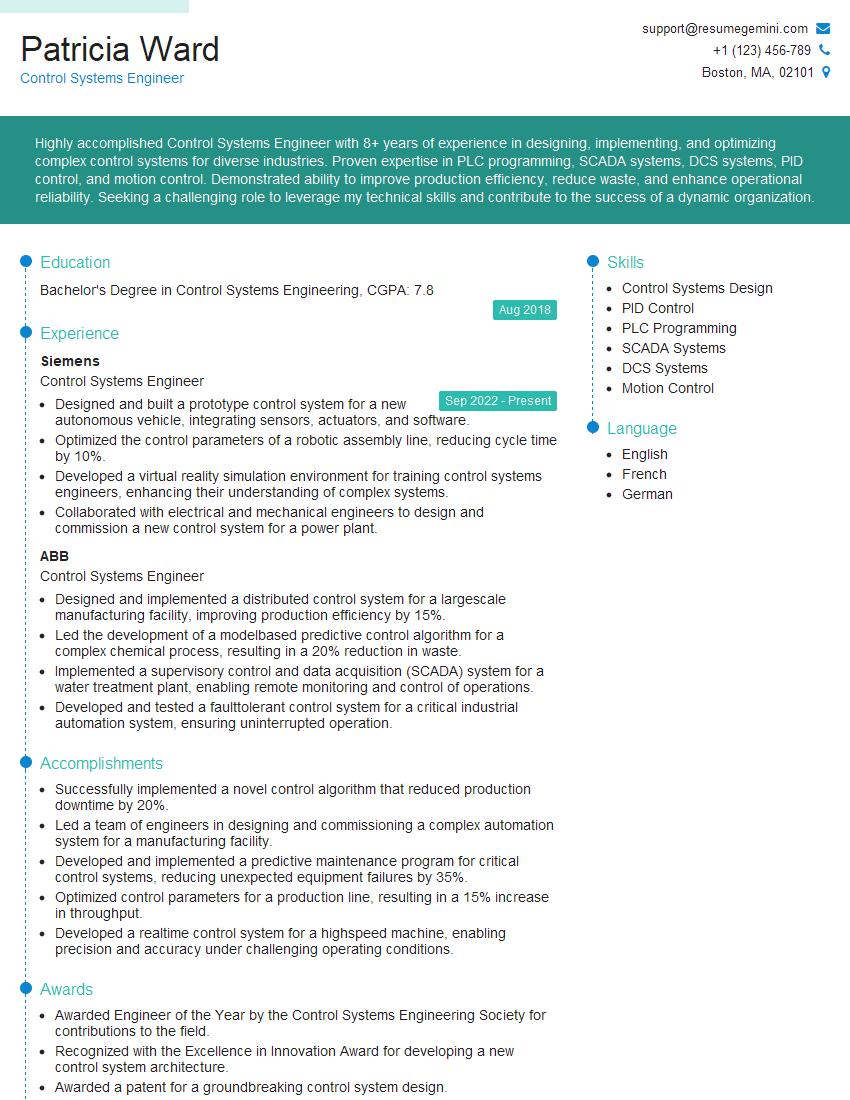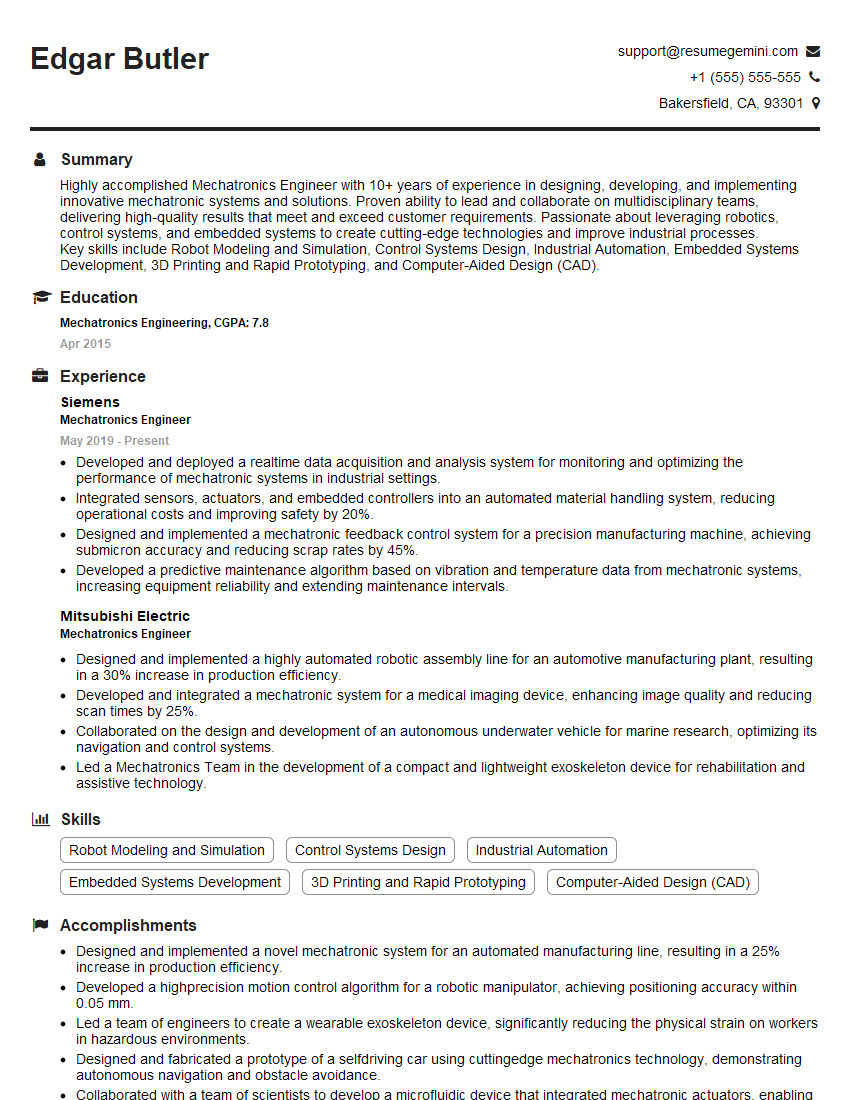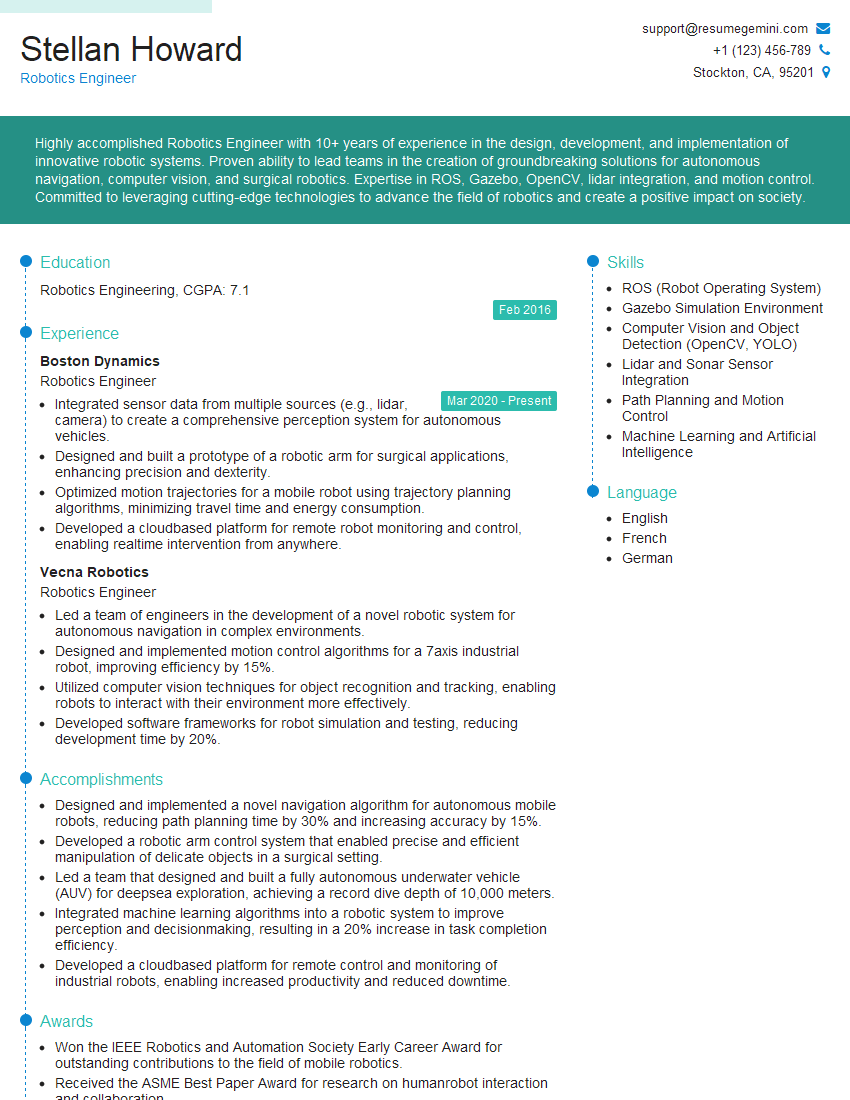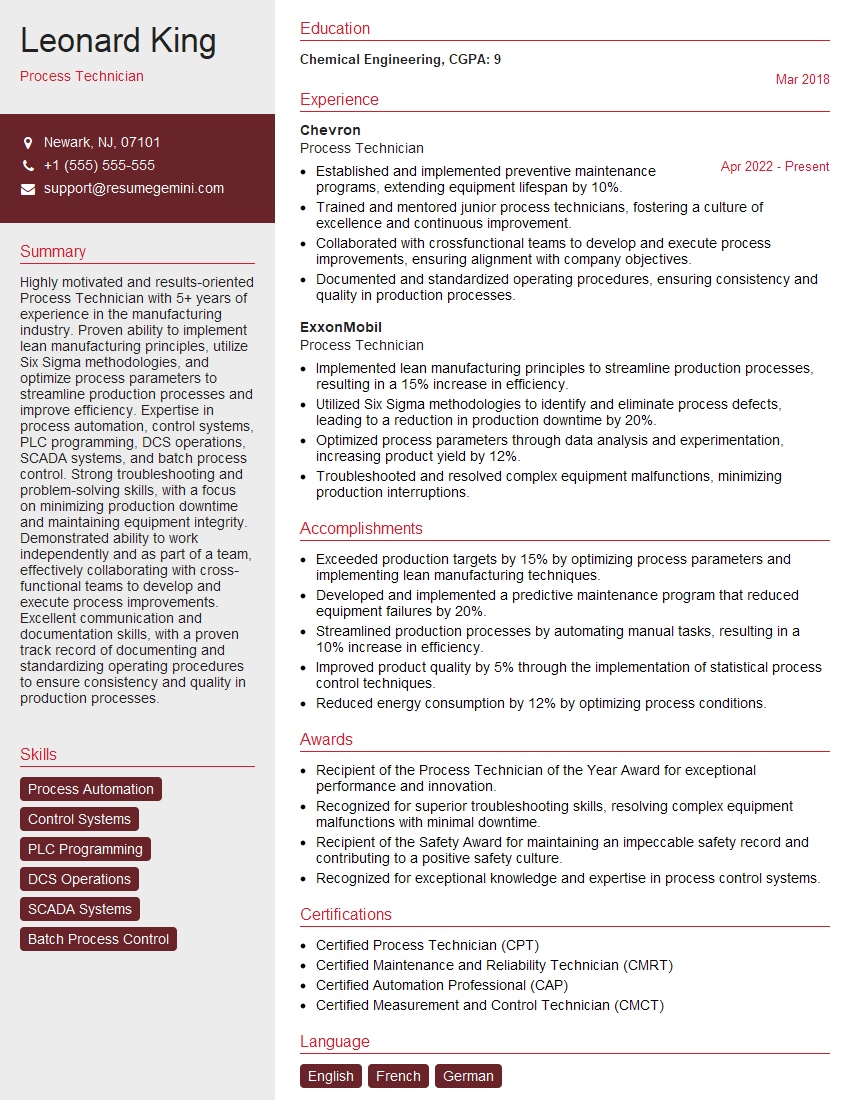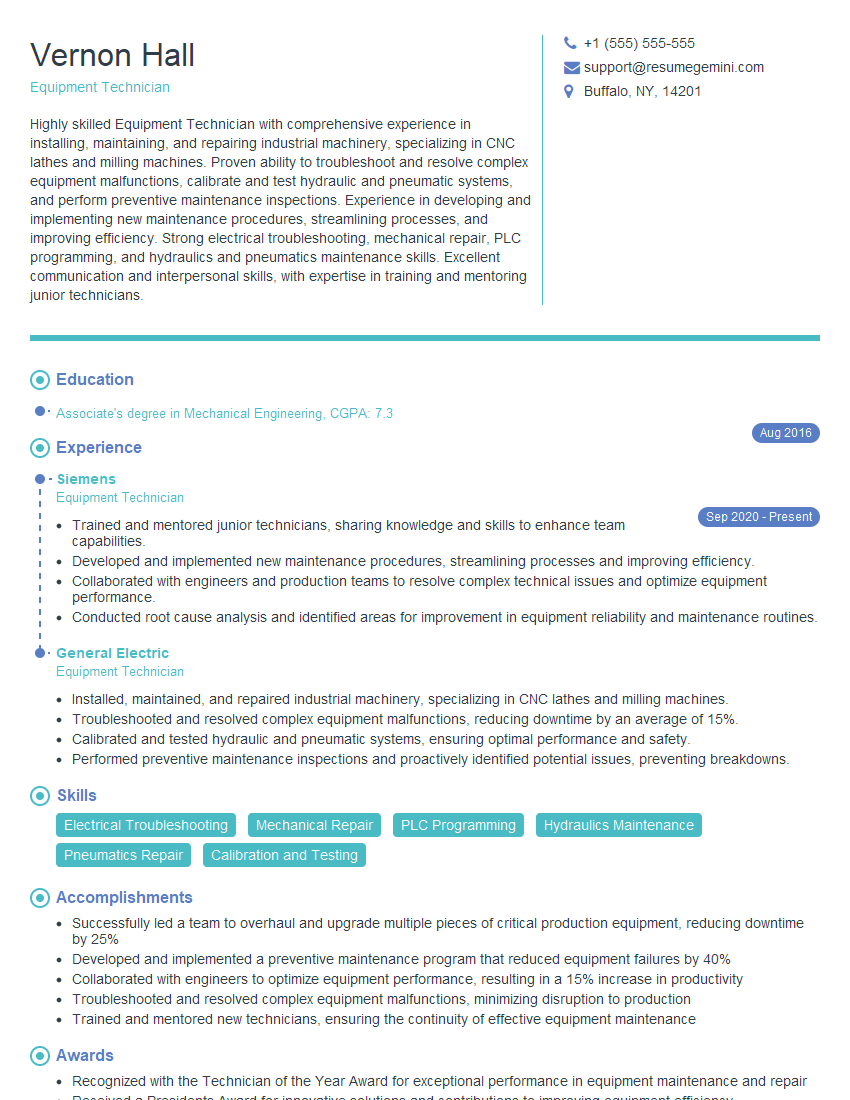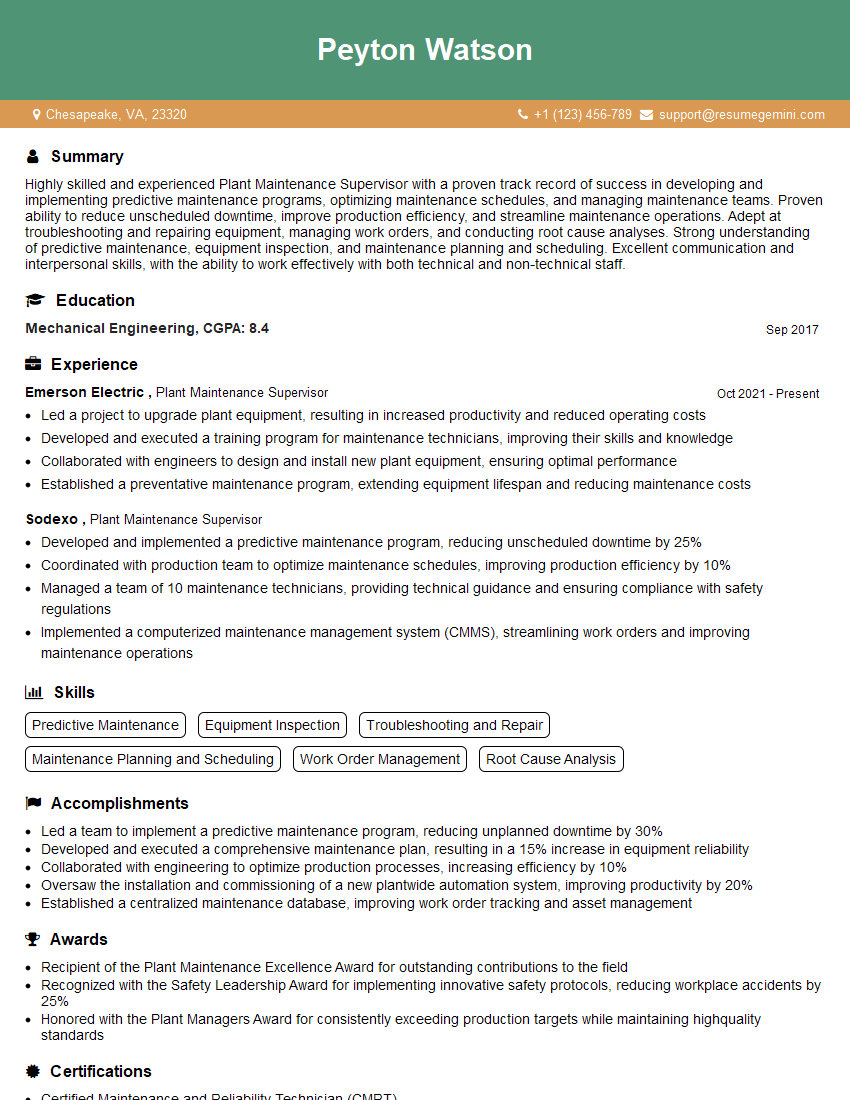Preparation is the key to success in any interview. In this post, we’ll explore crucial Equipment and Process Troubleshooting interview questions and equip you with strategies to craft impactful answers. Whether you’re a beginner or a pro, these tips will elevate your preparation.
Questions Asked in Equipment and Process Troubleshooting Interview
Q 1. Describe your experience with root cause analysis techniques.
Root cause analysis (RCA) is a systematic process for identifying the underlying causes of problems, not just the symptoms. My experience encompasses several techniques, including the ‘5 Whys,’ fault tree analysis, and Fishbone diagrams. The 5 Whys involves repeatedly asking ‘why’ to peel back layers of explanation until the root cause is uncovered. For example, if a pump fails, the 5 Whys might go: 1. Why did the pump fail? (Bearing seized). 2. Why did the bearing seize? (Lack of lubrication). 3. Why was there a lack of lubrication? (Lubrication system malfunctioned). 4. Why did the lubrication system malfunction? (Sensor failure). 5. Why did the sensor fail? (Age and wear). This reveals the root cause as sensor failure due to age and wear, not just the immediate symptom of a seized bearing. Fault tree analysis uses a graphical representation to show the various potential causes leading to a failure. Fishbone diagrams (Ishikawa diagrams) visually organize potential causes categorized by factors like equipment, materials, methods, environment, and people. I select the most appropriate technique based on the complexity and context of the problem.
Q 2. Explain your approach to troubleshooting a malfunctioning piece of equipment.
My approach to troubleshooting malfunctioning equipment is methodical and data-driven. It starts with safety – ensuring the equipment is isolated and secured before any investigation. Next, I gather information: I review operating logs, alarm history, and any previous maintenance records. Then, I visually inspect the equipment for obvious signs of damage or malfunction, such as leaks, loose connections, or unusual noises. Based on this initial assessment, I develop a hypothesis about the potential cause. I then utilize diagnostic tools (discussed later) to validate or refute my hypothesis. If necessary, I will systematically test components to pinpoint the faulty part. Throughout this process, I meticulously document every step, observation, and test result. This documentation aids in resolving the issue and prevents future recurrences. Finally, after repairing or replacing the faulty component, I thoroughly test the equipment to verify its proper functioning before returning it to service. This iterative process – observe, hypothesize, test, document, and verify – ensures an efficient and effective resolution.
Q 3. How do you prioritize troubleshooting tasks in a high-pressure environment?
Prioritizing troubleshooting tasks in a high-pressure environment requires a structured approach. I use a risk-based prioritization method, considering factors like the severity of the impact on production, safety risks, and the potential for escalation. The following matrix helps:
- Critical: Immediate safety hazard, complete production shutdown – addressed immediately.
- High: Significant production loss, potential safety concern – addressed with high priority.
- Medium: Moderate production loss, minimal safety risk – addressed as soon as possible.
- Low: Minor production impact, no safety concern – addressed during scheduled maintenance or less critical periods.
This matrix, coupled with clearly defined escalation paths, allows me to effectively manage multiple issues concurrently, focusing resources where they are most needed. For example, a safety-critical alarm would always supersede a minor equipment malfunction.
Q 4. What are the common causes of process deviations in your field?
Common causes of process deviations in my field are varied and often interconnected. They can be broadly categorized into:
- Equipment malfunctions: Pump failures, sensor inaccuracies, valve leaks, or control system errors.
- Material variations: Changes in raw material quality, inconsistent feedstock, or contamination.
- Human error: Incorrect operating procedures, insufficient training, or procedural deviations.
- Environmental factors: Temperature fluctuations, humidity changes, or power outages.
- Software/Control system glitches: Programming errors, software bugs, or communication failures within the automation system.
Often, a single deviation is caused by a combination of these factors. For instance, a slight change in feedstock (material variation) could cause a sensor to exceed its tolerance (equipment malfunction), leading to an incorrect control system response (software glitch) and, ultimately, a process deviation.
Q 5. How do you utilize diagnostic tools and equipment during troubleshooting?
Diagnostic tools and equipment are vital for effective troubleshooting. The specific tools vary depending on the equipment and process, but common examples include:
- Multimeters: For measuring voltage, current, and resistance in electrical circuits.
- Infrared (IR) cameras: For detecting overheating components or identifying leaks in thermal systems.
- Vibration analyzers: For diagnosing mechanical problems in rotating equipment like pumps and motors.
- Data acquisition systems (DAQ): For collecting and analyzing process data to identify trends and anomalies.
- Specialized software: PLC programming software, HMI software, and SCADA systems allow for monitoring and analysis of process parameters.
For example, using an IR camera to detect a hot bearing on a motor confirms a potential lubrication problem, while a DAQ system may reveal a consistent pressure drop indicating a valve leak. These tools enable a data-driven approach, reducing reliance on guesswork and improving diagnostic accuracy.
Q 6. Describe a time you identified a recurring equipment failure. How did you resolve it?
I once encountered recurring failures in a crucial valve within a high-pressure pipeline. Initially, the issue was attributed to operator error. However, the failures continued, prompting a more in-depth investigation. By analyzing the maintenance logs, I noticed a pattern: failures always occurred after prolonged periods of high-pressure operation. Using a vibration analyzer, I discovered excessive vibration during these periods, pointing towards a mechanical issue within the valve itself. Upon disassembling the valve, I found that a critical internal component was not properly seated, leading to increased wear and eventual failure under high pressure. The solution involved modifying the valve’s internal components to improve the seating of that component, thereby preventing the excessive vibration. Following this modification, the recurring failures ceased. This highlighted the importance of thorough data analysis, identifying patterns, and not jumping to premature conclusions. The root cause was not operator error, but a mechanical design flaw.
Q 7. Explain your understanding of preventative maintenance and its role in troubleshooting.
Preventative maintenance (PM) is crucial for reducing equipment failures and improving overall process reliability. It involves scheduled inspections, lubrication, cleaning, and component replacements to prevent malfunctions before they occur. A well-defined PM program significantly reduces troubleshooting needs. For example, regularly replacing worn-out bearings on a pump prevents catastrophic failure and costly downtime. Furthermore, PM facilitates early detection of potential issues through routine inspections, allowing for timely repairs before they escalate into major problems. While troubleshooting addresses existing failures, PM proactively prevents them, leading to improved process efficiency, reduced costs, and enhanced safety. PM also contributes directly to troubleshooting effectiveness; well-maintained equipment is easier to diagnose when problems arise because the set of potential causes is reduced. Thus, PM isn’t merely a separate activity; it’s a core aspect of preventing and resolving equipment issues.
Q 8. How do you document troubleshooting procedures and findings?
Thorough documentation is crucial for efficient troubleshooting. I use a multi-faceted approach, combining digital and physical records. For digital documentation, I prefer a structured format like a wiki or a dedicated database (e.g., a CMMS – Computerized Maintenance Management System). This allows for easy searching and updating. Each entry includes a clear problem description, steps taken, results, and any relevant images or diagrams. For instance, if a pump fails, I’d document the pump’s model number, the symptoms (e.g., no flow, unusual noise), the measurements taken (e.g., pressure, voltage), the troubleshooting steps (e.g., checking power supply, inspecting impeller), the identified root cause (e.g., clogged impeller), and the corrective action taken (e.g., impeller cleaning or replacement). This detailed record not only aids in resolving the current issue but also serves as a valuable reference for future troubleshooting and preventative maintenance.
Physically, I maintain a logbook near the equipment. This allows for quick notes during troubleshooting. Key information is then transferred to the digital system later for better organization and searchability. This method helps me keep track of immediate observations, and allows me to quickly jot down observations during troubleshooting, even if the system is offline.
Q 9. What safety procedures do you follow when troubleshooting equipment?
Safety is paramount. Before starting any troubleshooting, I conduct a thorough risk assessment, identifying potential hazards such as electrical shock, high-pressure systems, moving parts, or hazardous materials. I then implement appropriate control measures, which might include:
- Lockout/Tagout (LOTO): This is critical when working with energized equipment to prevent accidental startup. I strictly adhere to the company’s LOTO procedures.
- Personal Protective Equipment (PPE): I always wear appropriate PPE, such as safety glasses, gloves, hearing protection, and safety shoes, based on the specific hazards identified.
- Emergency Shutdown Procedures: I familiarize myself with emergency shutdown procedures for the equipment, ensuring I know how to quickly shut down the system if necessary.
- Working Permits: I always obtain necessary working permits, particularly for hazardous operations.
- Communication: I communicate clearly with colleagues about my activities to ensure everyone is aware of potential risks and my location.
I never compromise safety. If I’m uncertain about any aspect of the process, I seek guidance from a supervisor or a more experienced colleague before proceeding.
Q 10. How do you communicate technical issues to non-technical personnel?
Communicating technical issues to non-technical personnel requires clear and concise language, avoiding jargon. I use analogies and simple explanations to make complex concepts understandable. For example, instead of saying “The PID controller is experiencing a sustained oscillation,” I might say, “The system is constantly overcompensating, like a thermostat that keeps switching between too hot and too cold.”
Visual aids are also extremely helpful. Flowcharts, diagrams, and simple graphs can effectively illustrate the problem and the solution. I might show a simple flowchart depicting the process steps leading to the issue. I also tailor my language to the audience. If speaking to management, I focus on the impact of the problem and the proposed solution; if speaking to operators, I focus on the immediate actions they need to take.
Q 11. Describe your experience with PLC programming and troubleshooting.
I have extensive experience with PLC programming and troubleshooting, primarily using Siemens TIA Portal and Rockwell Automation Studio 5000. I’m proficient in ladder logic, structured text, and function block programming. I’ve worked on various PLC applications, including process control, automation systems, and SCADA integration. For troubleshooting, I utilize a systematic approach, starting with reviewing alarm logs and historical data. I then use diagnostic tools provided by the PLC to identify faulty components or program errors.
For example, I recently resolved a production line stoppage caused by a PLC program error. By examining the PLC’s fault logs and using online monitoring tools, I pinpointed the faulty section of the code, which involved a misconfigured timer. After correcting the code and uploading the revised program to the PLC, the production line resumed normal operation. My proficiency extends to network diagnostics, enabling me to troubleshoot communication issues between PLCs and other devices.
Q 12. How do you interpret process data to identify potential problems?
Interpreting process data is key to identifying potential problems. I typically start by examining trends in key process variables, looking for deviations from established baselines. For instance, I might look at temperature, pressure, flow rate, and level sensors. A sudden increase or decrease in any of these parameters could indicate a problem. I also look for correlations between different variables. For example, if the product temperature drops unexpectedly while the cooling water flow rate remains constant, it suggests a problem with the heating system.
Statistical process control (SPC) charts are invaluable. These charts help to identify patterns and deviations that might otherwise go unnoticed. I also use advanced analytics tools to identify anomalies in the data that suggest underlying issues. It’s like being a detective, piecing together clues to uncover the root cause of a problem.
Q 13. What software or tools are you proficient in for data analysis and troubleshooting?
I’m proficient in several software and tools for data analysis and troubleshooting. These include:
- Spreadsheet software (Excel, Google Sheets): For basic data manipulation and visualization.
- Data acquisition and visualization software (e.g., LabVIEW, Wonderware): For monitoring and analyzing real-time process data.
- Statistical software (e.g., Minitab): For advanced statistical analysis, including SPC charts.
- CMMS software (e.g., SAP PM, IBM Maximo): For tracking maintenance activities and analyzing equipment performance.
- Programming languages (Python, MATLAB): For custom data analysis and scripting.
The choice of software depends on the complexity of the data and the specific problem being addressed. Often, a combination of tools is used for a comprehensive analysis.
Q 14. How do you handle situations where troubleshooting requires collaboration with other teams?
Collaboration is essential, especially when troubleshooting complex issues. I begin by clearly defining the problem and identifying the relevant teams. This might involve production, engineering, maintenance, or even external vendors. I establish clear communication channels, ensuring regular updates and open dialogue. I utilize collaborative tools such as shared online documents or project management software to track progress and share information. I actively listen to other team members’ perspectives and consider their expertise, fostering a collaborative environment where everyone feels heard and valued.
For example, in resolving a major equipment failure, I worked closely with the electrical team to diagnose a power supply issue, the mechanical team to inspect the physical damage, and the vendor to obtain replacement parts. Open communication and clear roles ensured efficient problem resolution and a quick return to normal operations. Effective communication and a willingness to integrate other teams’ insights are crucial for success in this kind of collaborative environment.
Q 15. Explain your understanding of statistical process control (SPC).
Statistical Process Control (SPC) is a powerful methodology used to monitor and improve process capability and reduce variability. It uses statistical methods to analyze data from a process, allowing us to identify trends, patterns, and potential issues before they lead to significant problems. Think of it like a doctor taking your vital signs regularly – small deviations can be addressed before they become serious illnesses.
SPC relies heavily on control charts. These charts graphically display data points over time, with control limits indicating the expected range of variation. If a data point falls outside these limits, or a pattern emerges (like a series of points consistently above or below the average), it signals a potential problem needing investigation. Common control charts include X-bar and R charts (for process average and range), p-charts (for proportions), and c-charts (for counts).
For example, in a manufacturing process producing widgets, we might use an X-bar and R chart to monitor the widget’s weight. If the average weight consistently drifts above the upper control limit, it suggests a potential issue with the raw materials or the weighing machine. Investigating this early prevents producing a batch of overweight widgets that might need to be scrapped.
Career Expert Tips:
- Ace those interviews! Prepare effectively by reviewing the Top 50 Most Common Interview Questions on ResumeGemini.
- Navigate your job search with confidence! Explore a wide range of Career Tips on ResumeGemini. Learn about common challenges and recommendations to overcome them.
- Craft the perfect resume! Master the Art of Resume Writing with ResumeGemini’s guide. Showcase your unique qualifications and achievements effectively.
- Don’t miss out on holiday savings! Build your dream resume with ResumeGemini’s ATS optimized templates.
Q 16. Describe your experience with different types of sensors and their applications.
My experience with sensors is extensive, encompassing various types and applications. I’ve worked with:
- Temperature Sensors: Thermocouples, RTDs (Resistance Temperature Detectors), and thermistors for measuring temperatures in diverse processes, from ovens to chemical reactors. Understanding their accuracy, response time, and limitations is crucial for effective process control.
- Pressure Sensors: Strain gauge, capacitive, and piezoelectric pressure sensors for monitoring pressure in hydraulic and pneumatic systems, pipelines, and vessels. Knowing the difference between absolute, gauge, and differential pressure is essential for accurate readings.
- Flow Sensors: Coriolis, ultrasonic, and differential pressure flow meters to monitor fluid flow rates. Calibration and understanding flow characteristics (laminar vs. turbulent) are vital.
- Level Sensors: Ultrasonic, radar, and capacitance level sensors for measuring liquid levels in tanks and reservoirs. Correct sensor placement and consideration of material properties are critical.
- Proximity Sensors: Inductive, capacitive, and photoelectric sensors for detecting the presence or absence of objects, often used in automated systems. Proper sensor selection based on the target material and distance is key.
In each case, sensor selection depends on the specific application, considering factors like accuracy, range, response time, environmental conditions, and cost. For example, using a low-cost sensor in a high-precision application could lead to significant errors.
Q 17. How do you validate the effectiveness of your troubleshooting solutions?
Validating troubleshooting solutions is crucial to ensuring effectiveness and preventing recurrence of problems. My approach involves a systematic process:
- Verification: After implementing a solution, I carefully monitor the system parameters to ensure the problem is resolved. This may involve reviewing sensor readings, process logs, or observing the process directly.
- Data Analysis: I collect data before and after implementing the solution to quantitatively assess the impact. Statistical methods like control charts can help demonstrate a significant improvement.
- Root Cause Analysis: Even if the immediate problem is solved, I strive to identify the root cause to prevent similar issues in the future. This often involves detailed investigation and potentially using tools like fault tree analysis.
- Documentation: Thorough documentation of the problem, solution, and validation process is crucial for future reference and knowledge sharing within the team.
- Follow-up: I regularly check the system performance after the initial validation to ensure the solution remains effective and to catch any potential regressions.
For instance, if a pump was failing due to cavitation, I’d verify the fix by monitoring pump vibration, pressure, and flow rate. A significant reduction in vibration and an increase in efficiency would validate the solution. The root cause analysis might reveal inadequate suction head, necessitating a system modification to prevent recurrence.
Q 18. What are your strategies for managing time effectively during troubleshooting?
Effective time management during troubleshooting is essential. My strategies include:
- Prioritization: Identifying the most critical issues based on their impact and urgency is paramount. The Pareto principle (80/20 rule) is often applicable – addressing the 20% of problems causing 80% of the downtime is vital.
- Systematic Approach: Following a structured troubleshooting methodology, like the 5 Whys technique, ensures thorough investigation without wasted effort. This avoids chasing irrelevant leads.
- Resource Allocation: Efficiently allocating resources, including tools, personnel, and information, is critical. Collaborating with the right experts accelerates the process.
- Clear Communication: Maintaining open communication with stakeholders keeps everyone informed and ensures that all relevant data is promptly available.
- Documentation: Real-time documentation of progress helps to track efforts and avoid repetition. It also forms a valuable learning resource for future incidents.
In practice, this means quickly identifying whether the issue is a sensor malfunction, a minor adjustment needed, or a more complex problem requiring specialized skills. A quick initial assessment significantly influences how I prioritize my approach.
Q 19. Describe your experience with hydraulic or pneumatic systems troubleshooting.
Troubleshooting hydraulic and pneumatic systems requires a deep understanding of fluid dynamics, pressure control, and component functionality. My experience encompasses identifying issues like:
- Leaks: Locating and repairing leaks using pressure testing, dye penetrant inspection, or ultrasonic leak detection.
- Pressure Drop: Diagnosing pressure drops across components by analyzing pressure readings and identifying clogged filters, restricted lines, or faulty valves.
- Component Failures: Troubleshooting faulty pumps, compressors, cylinders, valves, or accumulators through visual inspection, pressure testing, and performance analysis.
- Contamination: Identifying and mitigating contamination issues due to particulate matter or moisture, which can severely impact system performance.
I’m proficient in using schematics and diagrams to trace fluid pathways and identify potential points of failure. For instance, a significant pressure drop across a hydraulic filter indicates the need for filter replacement or cleaning. Similarly, a slow-responding pneumatic cylinder might indicate a leak in the air line or a problem with the valve.
Q 20. How familiar are you with different types of control valves and their operation?
I’m familiar with a range of control valves, including:
- Globe Valves: Simple, versatile valves suitable for a wide range of applications. I understand their various internal designs (e.g., ball, plug, needle) and how they impact flow characteristics.
- Ball Valves: Quick-opening valves primarily used for on/off control but also available in modulating designs.
- Butterfly Valves: Compact valves that are efficient for larger diameter pipelines, but typically not suitable for precise control.
- Control Valves (Proportional, Integral, Derivative): I understand the operation of these valves which provide precise control of fluid flow based on process variables. PID control loops frequently incorporate these valves for maintaining optimal process parameters.
- Pneumatic and Electric Actuators: I am experienced in troubleshooting both pneumatic and electric actuators that drive control valves, ensuring they function correctly and respond appropriately to control signals.
Troubleshooting often involves understanding valve characteristics like Cv (flow coefficient), pressure drop across the valve, and actuator response time. For example, a sluggish response from a control valve might indicate a faulty actuator or problems within the control loop itself.
Q 21. Explain your approach to troubleshooting electrical circuits.
My approach to electrical circuit troubleshooting is systematic and methodical:
- Safety First: Always prioritize safety by ensuring power is isolated before working on any electrical circuits. Proper lockout/tagout procedures are crucial.
- Visual Inspection: Start with a visual inspection to identify any obvious damage, loose connections, or burned components.
- Schematic Review: Review the circuit schematic to understand the circuit’s function and trace the signal path. This helps pinpoint potential points of failure.
- Measurement: Using multimeters, I measure voltages, currents, and resistances at various points in the circuit to identify deviations from the expected values.
- Isolation: Through a process of elimination, I isolate sections of the circuit to pinpoint the faulty component.
- Component Testing: Faulty components can be tested individually using appropriate test equipment.
For instance, if a motor doesn’t start, I’d first check the power supply, then the motor windings for continuity, and finally, check the motor controller for proper operation. Thorough documentation of measurements and findings facilitates efficient troubleshooting.
Q 22. Describe your experience with troubleshooting mechanical systems.
My experience with troubleshooting mechanical systems spans over ten years, encompassing diverse industries such as manufacturing and process engineering. I’ve worked extensively with hydraulic, pneumatic, and electromechanical systems, diagnosing and resolving a wide array of issues, from minor component failures to complex system malfunctions. My approach is systematic, beginning with a thorough understanding of the system’s design and operational parameters. I utilize a combination of diagnostic tools, including vibration analyzers, pressure gauges, and thermal imaging cameras, to pinpoint the root cause of the problem. For instance, I once resolved a recurring production line jam by identifying a worn-out bearing in a conveyor system using vibration analysis, preventing significant production downtime. Another project involved diagnosing a hydraulic leak in a large press, which I traced to a faulty seal using pressure testing techniques.
I’m proficient in predictive maintenance techniques, allowing for early detection of potential mechanical failures before they escalate into major problems. This proactive approach minimizes unexpected downtime and reduces overall maintenance costs. My experience includes working with various types of machinery, including pumps, compressors, motors, and gearboxes. I am equally comfortable working on individual components or troubleshooting complete systems.
Q 23. How do you identify and mitigate potential safety hazards during troubleshooting?
Safety is paramount in any troubleshooting scenario. My approach prioritizes hazard identification and mitigation through a structured risk assessment. Before commencing any troubleshooting activity, I thoroughly review the equipment’s safety documentation, including lockout/tagout procedures, safety data sheets (SDS), and any relevant operational manuals. I then conduct a visual inspection of the equipment, identifying potential hazards such as exposed wiring, moving parts, high-pressure systems, and hazardous materials.
I always ensure I have the appropriate personal protective equipment (PPE), including safety glasses, gloves, hearing protection, and steel-toed boots. Lockout/tagout procedures are meticulously followed before working on energized equipment, eliminating the risk of accidental energization. In situations involving hazardous materials, I adhere strictly to the handling and disposal procedures outlined in the SDS. If I encounter a hazard I’m not qualified to address, I immediately escalate the issue to the appropriate personnel. Think of it like this: Safety isn’t just a checklist; it’s a continuous process that requires careful planning and execution.
Q 24. What are your strategies for continuous improvement in equipment and process reliability?
My strategies for continuous improvement in equipment and process reliability revolve around a combination of data-driven analysis, preventative maintenance, and operator training. I advocate for implementing a robust Computerized Maintenance Management System (CMMS) to track equipment performance, maintenance history, and spare parts inventory. This data provides valuable insights into equipment reliability, helping to identify recurring problems and pinpoint areas for improvement. For example, analyzing historical data might reveal a specific component that consistently fails, allowing for proactive replacement or design changes.
Preventative maintenance plays a critical role in extending equipment lifespan and reducing downtime. This includes regular inspections, lubrication, and replacement of worn-out components according to a schedule established through reliability analysis. Finally, well-trained operators are crucial to maintaining equipment reliability. Regular training programs on proper operation, maintenance, and safety procedures empower operators to identify and report potential problems early, preventing major failures.
Q 25. How do you balance immediate problem-solving with long-term preventative measures?
Balancing immediate problem-solving with long-term preventative measures requires a strategic approach that prioritizes both efficiency and sustainability. While addressing the immediate problem is crucial to restore normal operations, neglecting preventative measures will likely lead to recurring issues. My strategy employs a two-pronged approach: first, addressing the immediate problem using the most effective and efficient method to minimize downtime. Then, once the immediate issue is resolved, I dedicate time to analyzing the root cause of the problem and implementing preventative measures to prevent recurrence.
For example, if a pump fails due to bearing wear, the immediate solution is to replace the pump. However, the long-term solution involves investigating why the bearing failed (e.g., inadequate lubrication, overloading) and implementing changes to prevent future failures, such as improved lubrication schedules, load balancing, or even upgrading the pump to a more robust model. This holistic approach avoids a ‘fire-fighting’ mentality and establishes a foundation for sustainable equipment reliability.
Q 26. Describe a situation where you had to troubleshoot a complex problem with limited information.
In one instance, I was tasked with troubleshooting a malfunctioning automated packaging machine with limited information. The machine had suddenly stopped working, and the only available information was a cryptic error code and a frustrated production line. The machine’s documentation was unavailable, and the original engineers were no longer with the company. My approach was methodical and started with a careful visual inspection. I checked for obvious issues such as loose connections, damaged components, and blockages.
Next, I carefully examined the error code, searching online forums and technical databases for similar problems. I discovered some related error codes reported on a similar machine model, leading to some helpful suggestions. I gradually started isolating the problem by methodically testing various components, using my knowledge of automation systems and applying the process of elimination. I eventually traced the problem to a faulty sensor triggering the erroneous shutdown. After replacing the sensor, the machine resumed normal operation. This experience highlighted the importance of resourcefulness, systematic troubleshooting, and the value of online technical communities in challenging situations.
Q 27. What is your experience with using schematics, diagrams, and manuals for troubleshooting?
Schematics, diagrams, and manuals are essential tools in my troubleshooting arsenal. I’m proficient in reading and interpreting various types of technical documentation, including electrical schematics, pneumatic diagrams, hydraulic schematics, and mechanical drawings. I utilize these documents to understand the system’s design, identify component locations, trace signal paths, and understand the relationships between different parts of the system. For example, a P&ID (Piping and Instrumentation Diagram) is critical when troubleshooting a process system, allowing me to quickly identify the flow path of materials and the location of sensors and actuators.
Similarly, electrical schematics allow me to trace the flow of electrical signals and identify potential points of failure. When interpreting these documents, I often use highlighting, notes, and cross-referencing to help track my progress and identify the source of problems. I’m experienced with various software tools used to view and interact with these documents.
Q 28. How do you stay updated with the latest technologies and best practices in your field?
Staying updated with the latest technologies and best practices is crucial in a rapidly evolving field. I actively participate in professional organizations such as (mention relevant professional organizations), attend industry conferences and workshops, and read industry publications to stay abreast of advancements in equipment design, troubleshooting techniques, and predictive maintenance strategies. I also follow key industry influencers and participate in online forums and communities where experts share knowledge and best practices.
Furthermore, I consistently seek opportunities for professional development, including specialized training courses and workshops on advanced troubleshooting techniques and new technologies. This continuous learning ensures I remain at the forefront of my field and can effectively address emerging challenges.
Key Topics to Learn for Equipment and Process Troubleshooting Interview
- Understanding Process Flow Diagrams: Learn to interpret P&IDs and flowcharts to identify potential bottlenecks and failure points. This is crucial for understanding the entire system and anticipating problems.
- Root Cause Analysis Techniques: Master methods like the 5 Whys, Fishbone diagrams, and Fault Tree Analysis to effectively diagnose the underlying cause of equipment malfunctions, not just the symptoms.
- Preventive Maintenance Strategies: Demonstrate knowledge of scheduled maintenance procedures, predictive maintenance techniques (vibration analysis, oil analysis), and their impact on minimizing downtime and maximizing equipment lifespan.
- Troubleshooting Specific Equipment: Depending on your target role, focus on the specific equipment types (e.g., pumps, compressors, control systems) and their common failure modes. Be prepared to discuss practical experience with repair and maintenance.
- Safety Protocols and Procedures: Highlight your understanding and adherence to relevant safety regulations and lockout/tagout procedures. Safety is paramount in this field.
- Data Analysis and Interpretation: Showcase your ability to analyze sensor data, process parameters, and historical records to identify trends and predict potential issues. This includes familiarity with relevant software and tools.
- Communication and Teamwork: Emphasize your ability to clearly communicate technical information to both technical and non-technical audiences, collaborate effectively within a team, and document troubleshooting efforts thoroughly.
- Troubleshooting Methodologies: Describe your systematic approach to troubleshooting, including your process for gathering information, formulating hypotheses, testing solutions, and documenting findings.
Next Steps
Mastering Equipment and Process Troubleshooting is vital for career advancement in many high-demand industries. It demonstrates critical thinking, problem-solving skills, and a deep understanding of complex systems—all highly valued by employers. To maximize your job prospects, creating a strong, ATS-friendly resume is crucial. ResumeGemini can help you build a professional and impactful resume tailored to highlight your skills and experience in this field. Examples of resumes specifically designed for Equipment and Process Troubleshooting professionals are available to guide you. Take the next step and craft a resume that reflects your expertise and secures your dream job.
Explore more articles
Users Rating of Our Blogs
Share Your Experience
We value your feedback! Please rate our content and share your thoughts (optional).
What Readers Say About Our Blog
Hello,
We found issues with your domain’s email setup that may be sending your messages to spam or blocking them completely. InboxShield Mini shows you how to fix it in minutes — no tech skills required.
Scan your domain now for details: https://inboxshield-mini.com/
— Adam @ InboxShield Mini
Reply STOP to unsubscribe
Hi, are you owner of interviewgemini.com? What if I told you I could help you find extra time in your schedule, reconnect with leads you didn’t even realize you missed, and bring in more “I want to work with you” conversations, without increasing your ad spend or hiring a full-time employee?
All with a flexible, budget-friendly service that could easily pay for itself. Sounds good?
Would it be nice to jump on a quick 10-minute call so I can show you exactly how we make this work?
Best,
Hapei
Marketing Director
Hey, I know you’re the owner of interviewgemini.com. I’ll be quick.
Fundraising for your business is tough and time-consuming. We make it easier by guaranteeing two private investor meetings each month, for six months. No demos, no pitch events – just direct introductions to active investors matched to your startup.
If youR17;re raising, this could help you build real momentum. Want me to send more info?
Hi, I represent an SEO company that specialises in getting you AI citations and higher rankings on Google. I’d like to offer you a 100% free SEO audit for your website. Would you be interested?
Hi, I represent an SEO company that specialises in getting you AI citations and higher rankings on Google. I’d like to offer you a 100% free SEO audit for your website. Would you be interested?
good
